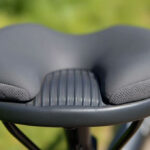
Bicycle turn signals are a critical part of cycling safety, especially in urban settings where cyclists share the road with motor vehicles. These turn signals communicate your intentions to other road users, reducing accidents and making your ride safer.
Here’s why bicycle turn signals are important:
- Communication: Clearly indicate your turning intentions to others.
- Predictability: Make your movements more predictable for smoother traffic flow.
- Legal compliance: Meet legal requirements to avoid fines and liabilities.
Urban cycling comes with its own set of challenges. Heavy traffic, narrow lanes, and numerous distractions can make it difficult for cyclists to maneuver safely. Turn signals provide a simple yet effective way to alert other road users of your next move. This can minimize the risk of collisions, protect pedestrians, and improve the overall flow of traffic.
In summary:
- Always use turn signals for safer cycling.
- Use arm signals for basic communication.
- Consider adding electronic signals for improved visibility and convenience.

The Importance of Bicycle Turn Signals
Bicycle turn signals are crucial for ensuring safe interactions between cyclists and other road users. Whether you’re on a traditional bike or an electric bicycle, these signals play a significant role in communication, predictability, and legal compliance.
Communication
Turn signals act as the voice of the cyclist on the road. By clearly indicating your turning intentions, you help other road users understand what you plan to do next. This simple act of signaling can significantly reduce accidents caused by unexpected maneuvers. For example, a driver who sees your left turn signal can slow down or change lanes to avoid a collision.
Imagine riding in heavy urban traffic. Without turn signals, your sudden lane change could surprise a nearby driver, leading to dangerous outcomes. Turn signals eliminate this uncertainty, making the road safer for everyone.
Predictability
When cyclists use turn signals, they become more predictable to drivers and pedestrians. Predictability is key to smoother traffic flow. If other road users can anticipate your movements, they can take necessary precautions to avoid potential dangers. This not only eases congestion but also protects cyclists from accidents.
Consider the scenario of a busy intersection. A cyclist signaling a right turn allows drivers behind to adjust their speed and position, reducing the chance of rear-end collisions. Predictable actions foster a safer and more harmonious road environment.
Legal Compliance
In many regions, signaling turns and lane changes is a legal requirement for cyclists. Failing to do so can result in fines or increased liability in case of an accident. Adhering to these regulations ensures personal safety and promotes responsible cycling practices.
For instance, the Federal Highway Administration has updated traffic regulations to include measures that improve safety for vulnerable road users, including cyclists. These updates emphasize the importance of clear communication through signals.

Legal compliance also builds a culture of accountability and respect on the road. By following the rules, cyclists contribute to a safer and more organized traffic system.
In summary, bicycle turn signals are essential for:
- Communication: Clearly indicating your intentions to other road users.
- Predictability: Making your movements more predictable for smoother traffic flow.
- Legal Compliance: Meeting legal requirements to avoid fines and liabilities.
Understanding and using bicycle turn signals can significantly improve your safety and that of others around you.
Types of Bicycle Turn Signals
Bicycle turn signals come in two main types: hand signals and electronic signals. Both are essential for safe cycling, especially in urban environments where communication with other road users is crucial.
Hand Signals
Hand signals are the traditional method for cyclists to indicate their intentions. They are simple, cost-effective, and universally recognized. Here’s a quick guide to the three basic hand signals every cyclist should know:
-
Left Turn: Extend your left arm straight out to the side, parallel to the ground. This signal is easily noticeable to drivers and pedestrians.
-
Right Turn: Extend your right arm straight out to the side. Alternatively, in some regions, you can extend your left arm out and upward at a 90-degree angle. This ensures visibility even if your right arm is less noticeable.
-
Stop: Raise and extend your left arm outward at a 90-degree angle with your palm facing behind. This signals to others that you are slowing down or coming to a stop.
While hand signals are effective in many conditions, they can be less visible in low light or adverse weather. In such cases, electronic turn signals can offer improved visibility and convenience.
Electronic Turn Signals
Electronic turn signals are a modern innovation designed to improve visibility and ease of use for cyclists. They typically feature LED lights and can be integrated into various parts of the bicycle or accessories like helmets. Here are some key benefits:
-
Increased Visibility: LED lights are bright and easily noticeable, making them highly effective in low-light conditions. This can significantly reduce the risk of accidents.
-
Ease of Use: Electronic signals are usually activated by switches or buttons on the handlebars, making them convenient to use without taking your hands off the bike.
Several products on the market offer different features to meet various needs. For example, the Smart Light Pro Dual combines turn signals with automatic brake lights, while the Lumos Firefly Helmet integrates high-visibility turn signals into the helmet itself.
Electronic turn signals can be especially beneficial in heavy traffic or during night rides. They provide a clear and consistent way to communicate your intentions to other road users, enhancing overall safety.

In summary, both hand signals and electronic turn signals play a vital role in cycling safety. Hand signals are straightforward and cost-effective, while electronic signals offer improved visibility and convenience. Depending on your riding conditions and preferences, you may find one type more suitable than the other.
Top 5 Bicycle Turn Signals for 2023
Choosing the right bicycle turn signals can significantly improve your safety on the road. Here, we review the top 5 options for 2023, focusing on their unique features and benefits.
Smart Light Pro Dual
The Smart Light Pro Dual is a versatile option that can be used both as a front and rear light. It comes with a UNIT 1 Remote that allows you to control turn signals and automatic brake lights seamlessly. The lights are USB-C rechargeable and offer up to 32 hours of battery life depending on the settings. This model also includes a charging case for on-the-go convenience, making it a comprehensive solution for all your cycling needs.

Key Features:
- Automatic Brake Lights: Activates when you slow down, ensuring you’re visible to everyone behind you.
- UNIT 1 Remote: Easy control of all lighting functions.
- Long Battery Life: Up to 32 hours depending on settings.
- Waterproof Rating: IP67, making it durable in various weather conditions.
BBR Tuning Bicycle 3-in-1 Tail Light & Turn Signal
The BBR Tuning Bicycle 3-in-1 Tail Light & Turn Signal is a fantastic choice for those looking for an all-in-one solution. It includes turn signals, a tail light, and a horn, all controlled by a single unit. The brake detector feature ensures the tail light brightens when you brake, adding an extra layer of safety.

Key Features:
- Horn: Alerts others of your presence with a 110db sound.
- Brake Detector: Automatically brightens the tail light when braking.
- Easy Installation: Requires only a couple of AA batteries and a screwdriver.
Lumos Firefly Helmet
The Lumos Firefly Helmet integrates high-visibility turn signals directly into the helmet, making it an excellent choice for cyclists who value head protection and visibility. The helmet features bright LED lights that are easily seen, even in low-light conditions.

Key Features:
- Helmet Integration: Turn signals are built into the helmet, ensuring they’re always at eye level.
- High Visibility: Bright LED lights make you easily noticeable.
- Comfort: Designed to be comfortable for long rides.
Varia Rearview Radar
The Varia Rearview Radar by Garmin is not just a turn signal; it also includes radar detection to alert you of vehicles approaching from behind. This feature is especially useful for road cyclists who ride in high-traffic areas. The system can be paired with a bar-end mirror for additional rearview visibility.
Key Features:
- Radar Detection: Alerts you to vehicles approaching from behind.
- Bar-End Mirror: Adds an extra layer of safety by enhancing rear visibility.
- Multiple Light Modes: Offers various lighting options to suit different conditions.
Bontrager Flare RT
The Bontrager Flare RT is a reliable option that combines multiple lights with remote control functionality. This setup allows you to easily manage your turn signals and other lights from the handlebars. The lights are also highly visible and designed to work well in both daylight and nighttime conditions.

Key Features:
- Remote Control: Easily manage lights from the handlebars.
- Multiple Lights: Provides comprehensive lighting for increased safety.
- Daylight Visibility: Designed to be visible even in bright daylight.
These top 5 bicycle turn signals offer a range of features to suit different needs and preferences. Whether you prioritize automatic brake lights, helmet integration, or radar detection, there’s a perfect option for you.
How to Install Bicycle Turn Signals
Installing bicycle turn signals is a straightforward process that can significantly improve your safety on the road. Below are the steps, tools needed, and some safety tips to help you get started.
Installation Steps
-
Choose the Right Turn Signal Kit
- Select a turn signal kit that suits your needs. Options range from handlebar-mounted signals to integrated helmet lights.
-
Gather Tools
- Screwdriver: For mounting brackets.
- Zip Ties: To secure wires.
- Rechargeable Batteries: If your kit requires them.
-
Mount the Turn Signals
- Handlebar Signals: Attach the mounting brackets to the handlebars using the provided screws.
- Seat Post Signals: Mount the rear turn signal onto the seat post. Ensure it’s positioned for maximum visibility.
-
Install the Control Unit
- Handlebar Remote: Mount the control unit on the handlebar where it’s easy to reach. Secure it with screws or zip ties.
- Helmet Remote: If your kit includes a helmet remote, follow the manufacturer’s instructions for attachment.
-
Connect the Wiring
- Battery Connection: Connect the signal lights to the battery pack, ensuring all connections are secure.
- Cable Management: Use zip ties to neatly run the wires along the frame of your bike, keeping them out of the way.
-
Test the System
- Function Check: Turn on the signals and verify that both the left and right signals light up correctly.
- Brake Light Check: If your system includes a brake light, test it by applying the brakes to ensure it activates.
Tools Needed
- Screwdriver: For securing mounting brackets.
- Zip Ties: For managing cables and wires.
- Rechargeable Batteries: Ensure your turn signals have power.
- Allen Wrench: Some kits may require an Allen wrench for mounting.
Safety Tips
-
Read the Manual
- Always read the manufacturer’s instructions to ensure proper installation.
-
Check Visibility
- Make sure the turn signals are visible from a distance. Position them where they can be easily seen by other road users.
-
Secure Connections
- Double-check all connections to ensure they are secure and won’t come loose while riding.
-
- Periodically check the turn signals and batteries to ensure they are functioning correctly.
-
Combine with Hand Signals
- Use hand signals in conjunction with electronic signals for added visibility, especially in low-light conditions.
By following these steps and tips, you can install bicycle turn signals effectively, enhancing your safety and communication on the road.
Frequently Asked Questions about Bicycle Turn Signals
What are the turn signals for cyclists?
Cyclists have two main types of turn signals: hand signals and electronic signals.
Hand signals are the traditional method. They involve extending your arm to indicate your intentions to turn or stop. They are simple, cost-effective, and universally recognized.
- Left Turn: Extend your left arm straight out to the side.
- Right Turn: Extend your right arm straight out or make an “L” shape with your left arm (arm bent upward at a 90-degree angle).
- Stop: Extend your left arm downward at a 90-degree angle.
Electronic signals are a modern alternative. These are LED lights mounted on your bike or helmet and activated via a remote. They are especially useful in low-light conditions and can include additional features like brake lights.
Are bike turn signals worth it?
Yes, bike turn signals are definitely worth it for several reasons:
Safety Benefits: Turn signals make your intentions clear to other road users, reducing the risk of accidents. According to a Reddit discussion, cyclists who use turn signals report feeling more confident and visible on the road.
Accident Prevention: By making your movements predictable, you help drivers and pedestrians anticipate your actions. This can prevent sudden maneuvers that might lead to collisions.
Legal Compliance: In many regions, signaling your turns is legally required. Failing to do so can result in fines or increased liability if an accident occurs.
What is the bicycle signal for right turn?
For a right turn, cyclists can use either a hand signal or an electronic signal.
Hand Signal: Extend your right arm straight out to the side. Alternatively, in some regions, extend your left arm bent at a 90-degree angle with your hand pointing upwards.
Electronic Signal: If you have an electronic turn signal system, simply press the button or switch on your handlebar remote to activate the right turn signal. These systems often feature bright LEDs that flash to indicate your turn.
Using both hand and electronic signals together can improve your visibility and ensure that all road users understand your intentions.
Conclusion
At Doot Scoot, we are committed to promoting eco-friendly urban mobility. Our mission is to make cycling safer and more enjoyable for everyone. By providing comprehensive reviews and in-depth guides, we help you make informed decisions about bicycle accessories like turn signals.
Bicycle turn signals are more than just a cool gadget; they are essential for safe urban cycling. They help communicate your intentions to other road users, making your movements predictable and reducing the risk of accidents. Whether you prefer traditional hand signals or modern electronic signals, using them can make a big difference in your safety and the safety of others.
We believe in a customer-centric approach. That’s why we offer valuable resources such as buyer’s guides, tutorials, and product reviews. Our goal is to support you in every step of your cycling journey, from selecting the best turn signals to installing them on your bike.
To stay ahead of trends and continue providing top-notch content, we constantly update our knowledge on the latest developments in eBike technology and urban mobility. By doing so, we ensure that you have access to the most relevant and helpful information.
For more tips, guides, and reviews on eBikes and accessories, visit Doot Scoot. Together, let’s light up your path to a safer and more sustainable way of commuting.
Adding the right bicycle turn signals to your ride can significantly improve your safety and confidence on the road. Make sure to check out our detailed reviews and choose the best option that suits your needs. Happy cycling!










